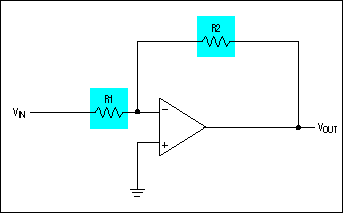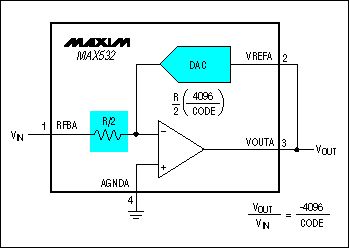

Programmable-Gain Amplifier, U
模拟技术
描述
Programmable-Gain Amplifier, Using the MAX532 DAC
Abstract: This application note discusses how to use the MAX532 to build a programmable gain amplifier (PGA) that's suitable for AC gain control. No external components are necessary. Equations are provided to easily calculate the output values.
The MAX532 is a dual, 12-bit, voltage-output DAC. Access to the output amplifier's input terminals allows it to be easily configured as a programmable-gain amplifier (PGA) suitable for AC gain control.
The circuit configuration is that of an inverting amplifier, with R2 replaced by the effective resistance of the DAC ladder (Figure 1) and R1 replaced by internal feedback resistor RFB (Figure 2). In this circuit, an AC signal is applied to the feedback resistor input and the output signal is tied to the DAC reference input. The maximum signal at VOUT is limited by the amplifier's headroom from the supply rails (±12V to ±15V), which must be a minimum of 2.5V from either rail.
Figure 1. Fixed-gain inverting amplifier. 
Figure 2. Programmable-gain amplifier.
The DAC functions as a programmable resistor in the feedback of the amplifier such that :
where R(DAC) is the resistance of the DAC ladder and RFB is the value of the feedback resistor, which is R/2.
R(DAC) = R/2×[4096/(DAC CODE)], with the DAC CODE given as a decimal value. As the code decreases, the effective DAC resistance increases, and so the gain increases. The transfer function for the circuit is thus:

The code can be programmed between 1 and full scale (212-1). Zero code is not allowed, as it results in the DAC's appearing as an open circuit in the feedback loop.
-
MAX41400: Low-Power, Precision Instrumentation Amplifier with Programmable Gain Data Sheet MAX41400: Low-Power, Precision Instrumentation Am2023-10-16 58
-
ADL592:250 MHz到2400兆赫变量Gain Amplifier过时的数据Sheet2021-05-14 645
-
AD603:低Noise,90兆赫变量Gain Amplifier数据Shet2021-05-07 713
-
LTC64331-20:20dB Gain街区,50if Amplifier数据Sheet2021-04-19 761
-
基于TQM879028下的0.7−4.0 GHz ½ W Digital Variable Gain Amplifier2018-08-03 1053
-
OPA692,pdf(Ultra Wideband, Fixed Gain Video Buffer Amplifier2010-09-27 904
全部0条评论

快来发表一下你的评论吧 !

